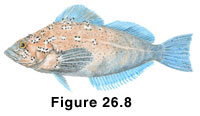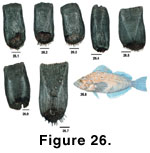 Description
DescriptionHexagrammos decagrammus
(Kelp Greenling)
(Other common names: Greenling Sea Trout, Speckled Sea Trout, Tommy Cod)
Figure 26.8
 Description
DescriptionLength: 60 cm.
Mouth: small, terminal, directed upwards; upper jaw reaches anterior point below eye orbit; snout is blunt with thickened lips; teeth moderate and in rows on the sides of the jaws and in patches at the tip.
Body: head is conical and compressed; one notched dorsal fin; caudal fin trucate or rounded; anal fin with one dorsal spine; erectable cirrus above and behind each eye; small pair of cirri in between eyes and dorsal fin; five lateral lines.
Color: males: brown to olive with blue or copper; blue spots on head and anterior portion of body; each blue spot has a round ring of reddish spots; dorsal and caudal fins are brown to black, pelvic fins dusky blue; pectoral fins spotted white. Females: light brown with orange to blue spots; dorsal fins red to orange with clouds of blue; pectoral fins pale yellow; both sexes have an ocellus on the posterior end of the dorsal fin; dark spots at the base of each eye.
Depth: up to 46 m.
Habitat: benthic in shallow waters; rocky and sandy substrate; common in with kelp beds.
Season: spawns in fall/winter with males actively guarding nest.
Diet: polychaetes, mussels (Fitch and Lavenburg, 1971), and small crustaceans.
Predators: salmonids (Pearcy et al., 1990).
Distribution: southern California to the Aleutian Islands (more common in northern waters).
 Scale
Description
Scale
DescriptionRelative Scale Size: small.
Position of Scales on Body: cover the upper part of the head and body along the five lateral lines (Hart, 1973).
Overall Shape: scales are rectangular, elongated in the anterior/posterior axis.
Focus and Circuli: the focus abuts the edge of the posterior field, along the edge of ctenii growth. Regeneration appears to be common. The circuli are not continuous between fields. The region of radii formation in the anterior field causes definite disruption of the circuli pattern. Within the anterior field/radii region itself, circuli are difficult to distinguish. Circuli in the lateral fields are well defined. The ridges are quite pronounced and thick.
Radii: numbers are variable and not diagnostic. Present only in the anterior field. The outer edge of the anterior field is slightly scalloped.